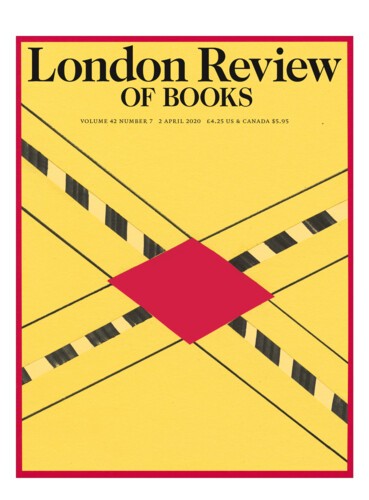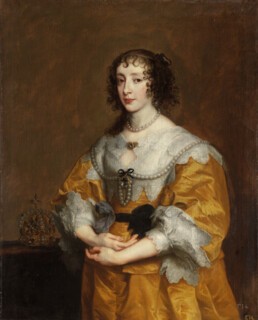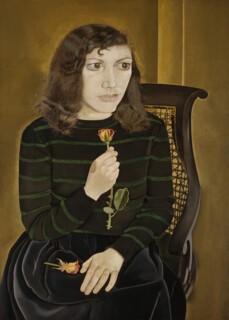Portraying Pregnancy: From Holbein to Social Media (until 26 April; temporarily closed) opens with images of the Visitation, the encounter in St Luke’s Gospel between the expectant Virgin Mary and her sixty-year-old cousin Elizabeth, improbably pregnant, in the days before IVF, with John the Baptist. The Visitation is the Second Joyful Mystery of the rosary. For those who grew up in Catholic Ireland, it was also a cautionary tale: if it happened to them, it could happen to you. Later in the exhibition, which includes paintings, prints, photographs, objects and clothing relating to pregnancy from the 15th century to the present, Edward Burne-Jones’s Annunciation (1876-79) shows the Virgin receiving news of her pregnancy from the Angel Gabriel. This (the First Joyful Mystery) preoccupied me from the age of nine or ten. I may not have got my period, I may have been years from letting any of the lads from school put a hand up my skirt in the handball alley, but the anxiety persisted. Gabriel might show up at any moment and announce that the Holy Spirit, in the shape of a dove, had descended in the dead of the night and knocked me up. (‘My mother’s a Jew, my father’s a bird,’ Buck Mulligan sings in Ulysses.)
Pregnancy begins as speculation. This exhibition reminds us that for most of history – before it was possible to pee on a stick and wait for a pink line, or to see a foetus via ultrasound – doctors had no failsafe way of confirming gestation. It wasn’t until 1927 that scientists detected HCG, a hormone produced by the placenta after implantation, in pregnant women’s urine. The first pregnancy test involved injecting baby rats with a sample: if HCG was present, the rats, despite their immaturity, started to behave as though they were on heat. Before this, diagnosis depended on patient testimony and medical guesswork. ‘Quickening’, movement in the womb during the second trimester, was ‘confirmatory evidence’ of gestation.
But bodies can be unreliable narrators. When Mary Tudor met the pope’s emissary on 29 November 1554, she felt the child stir inside her, as St Elizabeth had when the Virgin touched her stomach. ‘Exultavit infans in utero pius,’ the queen exclaimed to Cardinal Pole, directly referencing the Visitation. The previous day, Mary had sat in the great chamber at Whitehall Palace ‘richly apparelled, and her belly laid out, that all men might see that she was with child’. What was it these men saw? It was reported to Charles V that his daughter-in-law was exhibiting the ‘customary symptoms’ of pregnancy: her colouring, ‘the state of her breasts’, the fact that her dresses no longer did up. She was expected to give birth in May 1555; a nursery was prepared and a cradle carved. By the end of summer, hope was lost: the Venetian ambassador wrote that Mary’s pregnancy was more likely to ‘end in wind rather than anything else’. Another source claimed that she had given birth to a monkey.
Anthonis Mor’s portrait from 1554 depicts Mary in the throes of this phantom pregnancy, shortly after her marriage to Philip II. The queen is shown seated rather than standing, in the tradition of portraits of Habsburg brides, and the partlet concealing her shoulders and neck follows the conservative fashion of contemporary Spain. She is 37. What’s striking is her witheredness, her brittle grasp of the rose in her hand – a symbol of subservience to her Spanish consort. This is Bloody Mary drained of life, as in Victorian photographs where the subject seems to regard you from beyond the grave.
When the Bourbon princess Henrietta Maria married Charles I in 1625, she brought a fine pair of ovaries to the House of Stuart. Excluded from politics on account of her Catholicism, the queen had to busy herself pushing out babies: between March 1629 and June 1644, she had nine pregnancies that came to term (two of the children were stillborn). By all accounts, she was no looker – Samuel Pepys pronounced her ‘very little’ and ‘plain’ – but Van Dyck, like Titian, knew to flatter his paymaster. In Queen Henrietta Maria in Yellow (1636), for which she posed while six months pregnant with Princess Anne, he gives the queen a languorous aspect by painting her from below, exaggerating her height: compare this to Daniël Mytens’s portraits, in which her weak chin, large nose and limp curls are undisguised. No wonder Charles I gave Mytens the boot when Van Dyck moved to England in 1632. Van Dyck rescued the queen’s nose not by misrepresenting its scale, but by absorbing it within his sweeping, vertical lines. Despite the fluidity of his brushstrokes, his faces are full of detail: notice the dimple on the end of that nose. When Charles I’s youngest niece met Henrietta Maria, she remarked that ‘Van Dyck’s beautiful portraits had given me such a fine idea of all the ladies of England that I was surprised to see that the queen, whom I had seen as so beautiful and so slender, was a woman well past her prime. Her arms were long and lean, her shoulders uneven, and some of her teeth protruded from her mouth like tusks.’
How did Van Dyck imply the queen’s fecundity? Her gowns, which tended to obscure rather than emphasise the physique, didn’t help. The fashion Henrietta Maria brought with her from France was for an amorphous shape with a loose-laced bodice – a departure from the tightly corseted, inverted triangular numbers favoured by the Tudors and Elizabethans. When Holbein drew Cecily Heron, Thomas More’s third and youngest daughter, during her first pregnancy in 1527, the fitted bodice of her square-necked gown, loosened to accommodate her bulging stomach, told its own story. (Both Anne Boleyn and Jane Seymour were described as ‘unlaced’ during their pregnancies.) Van Dyck had to be more subtle. Happily, as the son of a silk merchant, he understood frocks. In Queen Henrietta Maria in Yellow, everything is meticulously arranged. The folds of gold satin fall elegantly around the body and the balance of Van Dyck’s composition means our gaze is drawn to the black sash tied just off-centre at the queen’s waist; crucially, below that, her hands are joined in a cradling gesture over her abdomen. She seems to offer her womb to the viewer: a royal pregnancy is after all a public event. (The same body language – hands on a swollen belly – sends strangers on the Tube scrambling to offer a seat.)
Many ‘pregnancy portraits’ qualify as such not because the sitter is showing, but because we can cross-reference the date of the painting with the date on which the sitter gave birth. (In Nicholas Hilliard’s portrait of his 22-year-old wife, Alice, from 1578 – a delicate miniature, watercolour on vellum – only the ear of corn and the pink rosebud pinned to her bodice allude to her pregnancy.) If we didn’t know that Princess Anne was born on 17 March 1637, would it be possible to tell from Van Dyck’s portrait that Henrietta Maria was pregnant? Not conclusively. And yet it’s the doubt that makes the most persuasive case for Van Dyck’s painting. After all, the success of a ‘pregnancy portrait’ depends on how well the artist gestures towards what can’t be straightforwardly represented.
Portraits seek to pin their subject in space, to confer a fixed identity on the sitter. The fantasy is that they will also reveal something of the person’s character. But when we talk about ‘character’, we’re often referring to something slippery and ineffable that lies beyond the composition of a face; its effect may be profound, but we understand its workings only dimly. Representing the queen in three-quarter profile, Van Dyck grants her depth in space; her gaze, which doesn’t meet the viewer’s directly, gives the impression of something seen – or thought, or felt – that we can’t entirely grasp. The light falls on the left side of her face; the right, marooned in shadow, signals everything that remains elusive when we take the measure of another person. A portrait may appear to be the ultimate celebration of the visible, yet in Van Dyck’s picture the queen’s unfathomable eyes hint at her pregnancy, that apotheosis of the hidden.
In the elite portraiture of the 18th century pregnancy was neither depicted nor alluded to – perhaps this is why the examples in Portraying Pregnancy left me cold – and its representation was confined to caricature. Satire doesn’t leave room for speculation about character: it tells you what to think. Hogarth’s March of the Guards to Finchley (1750), the gem in the Foundling Museum’s permanent collection, has been repurposed for this exhibition. The scene is the Tottenham Court Road turnpike during the Jacobite Rebellion of 1745: the guards, in their red coats and white spatterdashes, have gathered ahead of the march to Finchley Common. Drunken grenadiers fondle milkmaids and pilfer pies, prostitutes hang out of the windows of the tavern. In the midst of the chaos, a heavily pregnant ballad-seller bids farewell to her soldier sweetheart, while being accosted by an older woman (presumably the soldier’s wife). The girl’s right hand rests on the apron covering her belly – ‘the rising of the apron’ was a term used for pregnancy – but her bump is of interest only as an allegorical device. The wife sells Jacobite papers and the girl pro-Hanoverian ones: the soldier has to choose between a Protestant future represented by the ballad-seller’s baby and a Catholic one represented by his wife.
Similar works here include Isaac Cruikshank’s Frailties of Fashion, a parody of the short-lived vogue for belly pads that sprang up in London in 1793, and James Gillray’s Dido, in Despair (1801), which lampoons Emma Hamilton’s scandalous pregnancy by Lord Nelson. Seven months gone, Hamilton is portrayed as a grotesque battleaxe, arms and legs outstretched as she rises from bed in a bulging white nightgown and lace-trimmed cap to watch Nelson’s fleet vanish in the distance. To her right, an open book displays Hamilton’s once ravishing figure as painted by George Romney and others.
More intriguing is a spread from The Anatomy of the Human Gravid Uterus Exhibited in Figures (1774), a volume published by the accoucheur William Hunter and illustrated with copperplate engravings. In 1751, Hunter acquired the body of a young girl who died suddenly in the ninth month of pregnancy. (Most of the corpses available for dissection purposes belonged to criminals, and since pregnant women weren’t hanged it was rare to gain access to their dead bodies.) The woman’s legs have been sawn off at her thighs; she lies on her back with her abdomen opened, the skin peeled back carefully above the gash of her vagina. Gruesome but useful. Aids to obstetrical understanding had become vastly more detailed over the previous century. An ivory figurine from around 1680, created by the Nuremberg sculptor Stephan Zick, has articulated arms held in place at the shoulder by pegs. One hand lies alongside the body, while the other secures the abdomen in place. The arm can be lifted so that it rests on the forehead and the belly removed to reveal internal organs and a womb complete with an ivory foetus. These mannikins usually depicted the pregnant woman fully supine, as if on a funeral bier, and have the feel of memento mori.
Women in this exhibition have a bad time – the 20th century is no improvement. Augustus John’s Ida Pregnant (c.1901) shows his wife painted side on, leaning back into space, as if thrown off balance by her bump, which she clasps protectively, a manic glint in her eye. Is this how Ida looked or is it how John saw her? Did he believe, like many psychiatrists of the 20th century, in a ‘mental unhingeing round about the seventh month of pregnancy’? In her future there’s life on the road in a caravan with Augustus and his better-loved mistress, Dorelia; there’s the abandonment of her own painterly ambitions; and her death, aged 29, from a postpartum infection following the birth of her fifth child. (She had made ‘violent’ attempts to induce a miscarriage before the arrival of her fourth.)
These male depictions of the female body – depictions that force us to confront questions of agency and possession – are sometimes uncomfortable. That doesn’t make them incompatible with the experience of pregnancy – which, at its most fundamental, involves an alien body taking foothold in another person’s. The setting for Lucian Freud’s Girl with Roses is Delamere Terrace, where Freud lived with the pregnant Kitty Garman in 1947. Garman sits on a cane chair in the corner of a room, her body angled to her left and shoulders squared. Her right hand (with a prominent birthmark) is raised; she clutches a new rose just above the thorns. Freud, who never posed his subjects, made an exception on this occasion: ‘I was arranged,’ Garman later said. By any standard, not least Freud’s, Kitty is remarkably covered up; she wears a jumper with ribbed neck and green contoured stripes, and a voluptuous velvet skirt. But Freud’s meticulous naturalism and the translucence of his flesh tones lend an almost indecent air of exposure to the portrait. It’s easy to see why critics have interpreted Girl with Roses as a version of the Annunciation. We detect it in the static around Kitty’s hairline, in her coiled shoulders and the alarmed glint of her teeth through slightly parted lips. It’s as if unbidden news has come to her through the sash window whose reflection is visible in her enormous eyes: eyes that loom out at us, as one critic wrote, ‘like those of a huge rabbit in the far end of the pen’. All the available space on the canvas is crowded by her expressive urgency.
Freud painted many pregnant women, among them his 17-year-old lover Bernardine Coverley. In Pregnant Girl, 1960-61, she appears bare-breasted, her face averted: she wasn’t keen on posing. (‘I didn’t really see Bernardine for all that long,’ Freud later said. ‘She wouldn’t sterilise bottles, which I’m sure you are supposed to.’) In 1997, for Eight Months Gone, he painted a nude portrait of the pregnant supermodel Jerry Hall. A year later, when she was too ill to show up for a couple of sittings – having posed for months while Freud painted her breastfeeding – he punished Hall by substituting her face with that of his assistant David Dawson.
What did Lucian Freud know about pregnancy? Not very much, perhaps. But he did know about sex. The expression on Kitty’s face is not dissimilar to that of an animal before mating. It represents one half of a contradiction that’s germane to sexual experience, and that’s strangely replicated in pregnancy. It has to do with desire. On the one hand, there’s the urge to possess another person: to have sex, to have a baby, to take control. On the other, there’s the urge to be taken hold of, to lose oneself in somebody else, to be displaced by them. This is what Freud chose to represent when he painted Kitty: the craven terror that precedes abandon.
The best portraits in this show capture a pregnant subject in the act of being colonised: a foetus is a hijacker, the pregnant ‘they’ a compromised self. You experience this crisis of identity most acutely when you’re invisibly pregnant, in the first 12 weeks, when you’re tasked with growing a placenta and your plasma volume begins to spike, when your cardiac output increases by 30 per cent, when the embryo, barely the size of a blueberry, has you jumping off the 59 bus every morning somewhere around Kennington Post Office to throw up on the pavement. Slowly, you adjust. The hijacker needs leg room and you yield. Your stomach swings upwards, your internal organs squish together, your liver and lungs contort. The sickness, somehow, passes. It’s like Stockholm syndrome.
Send Letters To:
The Editor
London Review of Books,
28 Little Russell Street
London, WC1A 2HN
letters@lrb.co.uk
Please include name, address, and a telephone number.



